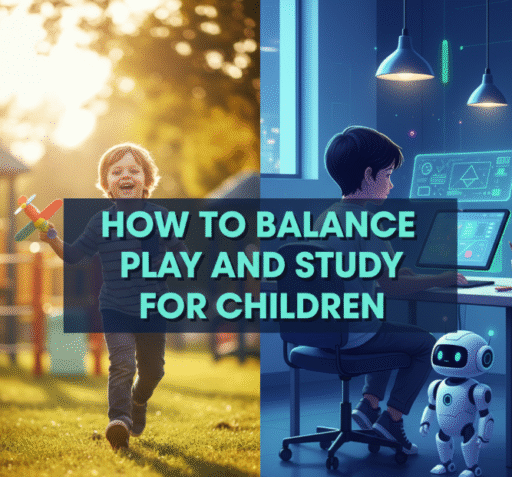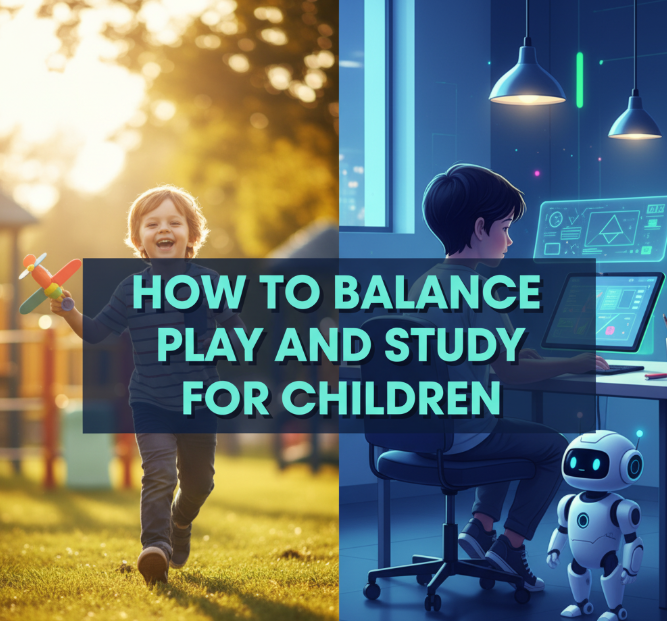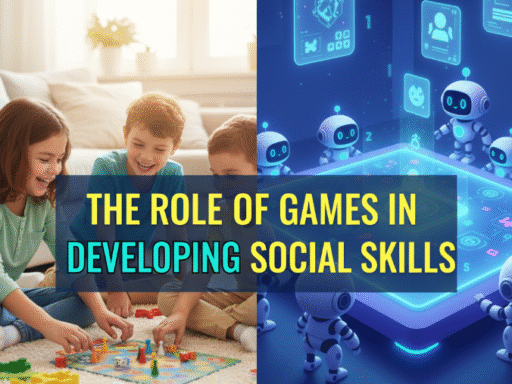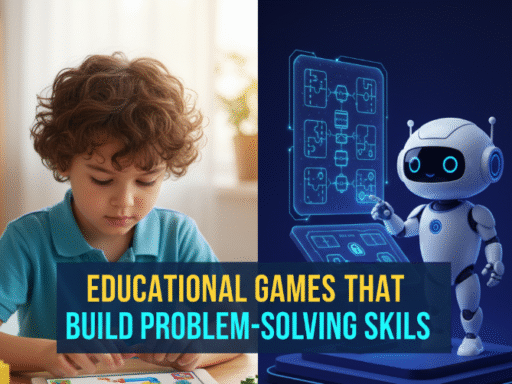Introduction: The Tug of War Between Books and Fun
Every parent faces the challenge of helping children balance playtime and study. Too much play may lead to poor grades, while too much studying can make kids feel stressed and disconnected. The truth is, both study and play are equally important for a child’s growth. Education sharpens the brain, but play builds creativity, confidence, and social skills.
The real trick is not choosing between the two, but learning how to combine study with play in a healthy way. In this article, we’ll explore practical tips, routines, and strategies to help children manage their time wisely while keeping the joy of childhood alive.
Why Balance Matters for Children
Children thrive in environments where they feel motivated yet free. Striking the right balance between books and fun helps in:
-
Healthy brain development – Studies show that physical play boosts memory, concentration, and problem-solving.
-
Better academic performance – Children who get regular breaks and leisure perform better in school.
-
Reduced stress and anxiety – A balance prevents mental burnout and keeps kids happy.
-
Life skill development – Play teaches teamwork, creativity, and resilience.
Signs of an Imbalance
Before creating a balance, it’s important to identify if a child is leaning too much toward one side.
Too Much Study
-
Lack of interest in social activities
-
Irritability and stress
-
Difficulty sleeping or feeling anxious
-
Weak physical fitness
Too Much Play
-
Falling behind in schoolwork
-
Lack of focus during study hours
-
Missing homework or deadlines
-
Overdependence on gadgets or outdoor play
A healthy balance avoids both extremes.
Setting the Right Foundation: Family’s Role
Parents play a key role in setting the rhythm for kids. A home environment that values both learning and fun is crucial.
What Parents Can Do
-
Be role models – Show children that work and relaxation go hand in hand.
-
Communicate openly – Ask kids what they enjoy studying and playing.
-
Avoid comparisons – Every child has a different pace of learning and playing.
-
Encourage responsibility – Let kids choose their own activities within limits.
Creating a Balanced Daily Routine
One of the most effective strategies is building a routine that respects both study and play.
Sample Balanced Schedule (For School-Going Kids)
| Time | Activity |
|---|---|
| 6:30 – 7:30 AM | Wake up, light exercise, breakfast |
| 7:30 – 1:30 PM | School hours |
| 2:00 – 3:00 PM | Lunch + short rest |
| 3:00 – 5:00 PM | Homework and study |
| 5:00 – 6:30 PM | Outdoor play/sports |
| 6:30 – 7:30 PM | Creative play (art, puzzles) |
| 7:30 – 8:30 PM | Family time + dinner |
| 8:30 – 9:30 PM | Light revision/reading |
| 9:30 PM | Sleep |
This schedule can be adjusted depending on the child’s age, school timing, and personal needs.
Study Strategies That Keep Kids Motivated
Children don’t always enjoy studying. But smart strategies can make it less stressful.
Break Study into Chunks
-
Use the Pomodoro technique: 25 minutes of study, 5 minutes break.
-
After 2–3 sessions, give a longer break with some light play.
Make Learning Interactive
-
Use flashcards, puzzles, or educational games.
-
Watch documentaries or YouTube lessons related to subjects.
Reward Small Achievements
-
Praise after completing homework.
-
Small rewards like extra playtime, stickers, or a favorite snack.
Playtime That Builds Skills
Not all play is equal. Certain games strengthen memory, problem-solving, and creativity.
Types of Play That Help Learning
-
Outdoor Sports – Boosts teamwork, leadership, and physical strength.
-
Board Games – Enhances focus, patience, and strategy.
-
Creative Play (Art, Music, Craft) – Encourages imagination and fine motor skills.
-
STEM Toys – Lego, robotics kits, and science experiments support logical thinking.
Mixing Play with Study
Parents often think of play and study as separate, but combining them makes learning fun.
How to Blend the Two
-
Math through games: Use dice, cards, or online games for arithmetic practice.
-
Storytelling for history/language: Act out historical events or make puppet shows.
-
Science experiments at home: Turn study topics into fun DIY projects.
-
Learning apps: Mix screen time with educational apps and quizzes.
This makes children feel that studying is not a burden but a fun journey.
Time Management Skills for Kids
Children who learn time management early succeed not just in school but in life.
Simple Ways to Teach Time Management
-
Use colorful planners and calendars.
-
Break tasks into “urgent,” “important,” and “fun.”
-
Teach the 80/20 rule – 80% focus on school, 20% on play (during weekdays).
-
Introduce timers and alarms for study/play intervals.
Role of Schools in Balancing Play and Study
Schools also play a huge role in helping kids balance. A good school system promotes academic excellence with co-curricular activities.
Schools Should Provide
-
Daily recess and physical activity
-
Sports teams and art clubs
-
Flexible homework loads
-
Creative teaching styles (debates, projects, group work)
When schools encourage play, children learn better.
Age-Specific Balance Tips
For Preschool Kids (3–5 years)
-
Focus more on play-based learning.
-
Reading time should feel like storytelling, not formal study.
-
Encourage puzzles, drawing, and songs.
For Primary School Kids (6–10 years)
-
Divide the day into study blocks and play breaks.
-
Encourage outdoor sports over gadget play.
-
Use games to teach basic subjects.
For Middle School Kids (11–14 years)
-
Teach time management with planners.
-
Encourage independent study with regular breaks.
-
Sports, music, or art should be part of weekly activities.
For Teenagers (15–18 years)
-
Help them prioritize study for exams but ensure relaxation.
-
Stress on outdoor sports to avoid too much screen time.
-
Teach self-discipline to manage both studies and social play.
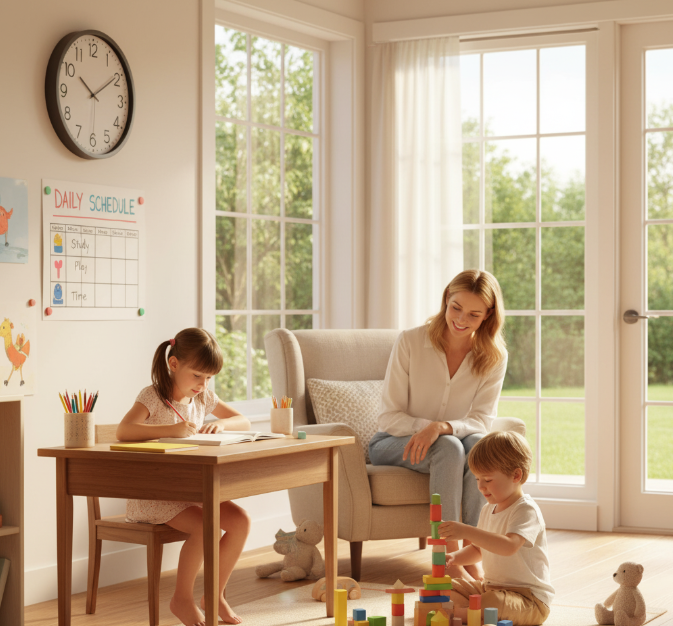
How to Balance Play and Study for Children
Common Mistakes Parents Make
Even with good intentions, parents may sometimes go wrong.
-
Overloading kids with tuition or homework
-
Allowing unlimited gadget play as a reward
-
Comparing children with siblings or friends
-
Ignoring mental health in pursuit of good grades
Avoiding these mistakes ensures kids grow happier and smarter.
Quick Tips to Keep Balance Everyday
-
Fix a daily study-play ratio (e.g., 2 hours study, 1 hour play).
-
Use weekends for more creative play and family trips.
-
Track progress with weekly check-ins.
-
Encourage hobbies like reading, gardening, or coding.
Infographic Idea: Study vs. Play Benefits
(You can visualize this in a colorful chart for your site.)
Study Benefits: Knowledge, discipline, academic growth
Play Benefits: Creativity, fitness, social skills
A balanced child = Smart + Happy + Healthy
Conclusion: The Secret to Raising Well-Rounded Kids
Balancing play and study is not about strict schedules or constant rules. It’s about creating a lifestyle where learning and fun naturally flow together. A child who studies well but also plays regularly is more confident, creative, and emotionally strong.
Parents, teachers, and kids must work together to build a healthy balance. When children learn early that play and study complement each other, they grow into successful, well-rounded adults.
The key takeaway: Let your child enjoy books and playtime equally—because both are stepping stones to a brighter future.
